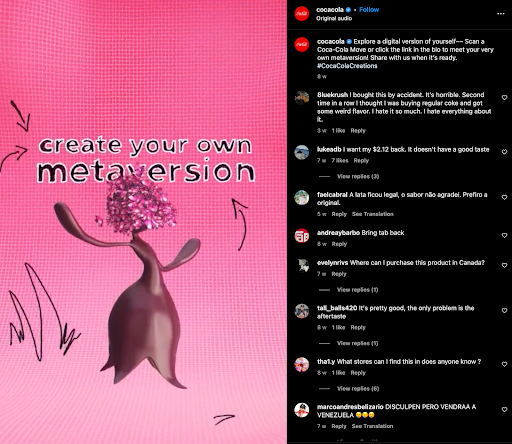Marketing In The Metaverse: How to Build Your Brand Identity in a Virtual World
The metaverse is rapidly expanding. As a new hyper-realistic zone for all things immersive, Web3 has become the newest hotspot for keen gamers, tech enthusiasts, and now brand giants.
“The metaverse is where our real-world physical self interacts and immerses with digital worlds,” says Engine Creative’s Andrew Wise. As the lines continue to blur between the physical and digital world, all aspects of our daily lives are moving online, especially the brands we interact with and consume.
From Gucci Garden to Fiat’s virtual showing room, the metaverse has become a creative hub for brands to try out new forms of advertising, appeal to a new digital demographic, and grow their online image.
However, as popular virtual platforms like Roblox and Fortnite rake in up to 400 million users as of 2023, introducing the metaverse to your branding strategy is no longer an innovation but a must-have.
The Future of Digital Brands
Digital branding is a company essential in 2023. Whether you’re promoting client services or clothing, prioritizing a digital image is the key to staying connected with customers and providing a personalized, unbeatable experience.
Introducing targeted social campaigns and AI-driven chatbots has only bolstered consumer engagement in recent years, and the metaverse hopes to take this one step further.
As technology evolves, so do the opportunities for digital brands. According to the CEO of Epic Games, Tim Sweeny, while we might not see an instant shift in digital branding, the cornerstones have been set in place for a gamified future of advertising.
“It’s not going to be a massive sudden disruption,” Sweeny states. “It’s going to be a meeting place for individuals and creators of all sizes, including brands. Every company will be there at some point.”
With over 500 leading companies now actively participating in the metaverse, the time for watch and wait is over. Read on as we discuss how you can transport your own brand to a virtual world and build a marketing strategy that prioritizes an immersive tomorrow.
Create Immersive Experiences
One of the key driving points of the metaverse is the ability to experience hyper-realistic immersivity. Through either virtual or augmented reality, users can tap into new worlds and physically experience visual and audio sensations.
In the US alone, Insider predicts that there will be more than 185 million AR/VR users by 2025, making immersive platforms a key center for branding potential.
Giving your consumers new ways to experience your brand is a great way to stay relevant. Whether you choose to gamify your advertising efforts or use the metaverse to present live presentations to prospective clients, immersive enhancements can be beneficial to both B2C and B2B marketing strategies.
If you’re a clothing brand, why not follow in the footsteps of Balenciaga and Nike and let Avatars try on your products?
Or alternatively, as a B2B company, why not transport your client meetings to an alternate dimension? From 3D demos to hyper-realistic boardroom meetings, you’ll certainly stand out as a digital pioneer.
A great example of a brand giant embracing the metaverse’s full potential is Gucci. As a leading pioneer in creating a virtual brand experience, the high-end clothing company has been quick to embrace VR technologies for Web3 e-commerce.
Collaborating with popular metaverse platform Roblox in 2021, the release of Gucci Garden demonstrated just how powerful virtual branding can be when growing your identity. With the ability to virtually explore six Gucci-themed game rooms, packed full of unique designs and purchasable NFTs, Gucci combined platform gaming with online marketing.
Raking in 1 million visitors, this immersive experience alone boosted Gucci’s brand awareness and rendered them a key brand player among 18-35-year-olds.
On the back of their success, a whopping half of all fashion brands are now using at least one form of augmented or virtual reality to showcase their products and brand identity in 2023.
Use the metaverse for your individual goals
While introducing AR/VR experiences is a key way to shape your brand identity in the metaverse, it’s important to also prioritize your individual brand goals.
Depending on your target audience and your product/service niche, each brand should approach the metaverse differently.
“If you are a car manufacturer, your brand presence in the metaverse isn’t going to be a bunch of advertising for your cars,” says Sweeny. “It’s going to be a place where you can actually drive the cars around and feel the experience of it.”
When building your brand identity in the metaverse, you must identify the key strategic objectives that your business is looking to achieve. Are you trying to build awareness, or are you directly aiming to sell a product?
This could significantly shift how your approach virtual branding. Introducing a platform game experience, like Gucci, could boost engagement and get consumers talking about your brand. However, if you’re looking to sell products directly, taking a leaf out of FIAT’s book could be the answer.

(Image Source: Stellantis)
Teaming up with Microsoft and Touchcast, FIAT has become the first large automobile manufacturer to offer a virtual, meta-infused showroom experience. Allowing consumers to virtually tour a 360-degree version of their new 500 La Prima by Bocelli model, they have quickly opened up their products to a global digital audience.
“In pure FIAT style, the FIAT Metaverse Store is the first of its kind in the automotive sector. It is a magical experience: an immersive human-driven journey into the world of FIAT. Simple and user-friendly, pursuing the idea of “tech it easy”, and accessible for everyone, thanks to its technology,” says Olivier Francois, Fiat’s CEO.
Unify immersive branding across all channels
If you want to develop a powerful presence online, unifying your branding strategy across all channels is essential.
Just unifying the color of your logo across social channels and your website increases brand recognisability by 80%, so it’s no surprise that this applies to the metaverse too.
The key here is to create a branding strategy that can be applied to both social channels and a virtual platform. If you continue to link back to all of your channels on all platforms, users will seamlessly be guided from one aspect of your brand to another.
Coca-Cola unifies its brand image easily, both in the metaverse and on its social channels. After jumping head first into virtual branding with their auction of an NFT Bubble jacket on Decentraland, the brand has since advertised their involvement in the metaverse on their Instagram channel too.
Introducing the ‘Make Your Own Metaversion’ video to their social feed, which links straight to their branded avatar creation studio, quickly unifies two different types of branding.

(Image Source: Coca-Cola)
This opens Coca-Cola’s metaverse marketing up to a broader audience and builds a reputable brand image across several platforms.
As we embrace the metaverse as a globe of digital natives, unification will be a brand prioritization as they embrace new virtual strategies. The metaverse should be viewed as an extension of your current branding rather than a totally new avenue.
Whether you introduce social media or learn how to start a blog, improving your digital footprint can create relationships with consumers like no other.
“Now is the chance for brands to get ahead by embracing the digital future,” claims Tech futurist Cathy Hackl. “The metaverse may seem like another thing to do as part of digital transformation. Instead, embrace the metaverse as an opportunity to expand your brands, what they do, and how they do it.”
The metaverse will still be here tomorrow, so it’s time to start embracing its potential. Brands that develop a virtual identity will thrive, while those who cower could be looking at a future of digital isolation.









